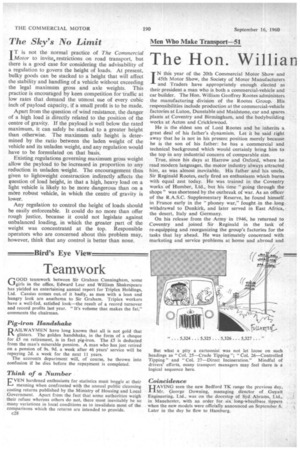The Sky's No Limit
Page 74

If you've noticed an error in this article please click here to report it so we can fix it.
I T is not the normal practice of The Commercial Motor to invite, estrictions on road transport, but there is a good case for considering the advisability of a regulation to govern the height of loads. At present, bulky goods can be stacked to a height that will affect the stability and handling of a vehicle without exceeding the legal maximum gross and axle weights. This practice is encouraged by keen competition for 'traffic at low rates that demand the utmost use of every cubic inch of payload capacity, if a small profit is to be made.
Apart from the question of wind resistance, the danger of a high load is directly related to the position of the centre of gravity. If the payload is well below the rated maximum, it can safely be stacked to a greater height than otherwise. The maximum safe height is determined by the ratio between the laden weight of the vehicle and its unladen weight, and any regulation would have to be formulated on that basis.
Existing regulations governing maximum gross weight allow the payload to be increased in proportion to any reduction in unladen weight. The encouragement thus given to lightweight construction indirectly affects the ituestion of load height, in that a high, heavy load on a light vehicle is likely to be more dangerous than on a more robust vehicle, in which the centre of gravity is lower.
Any regulation to control the height of loads should be easily enforceable. It could do no more than offer rough justice, because it could not legislate against unbalanced loading, in which the greater part of the weight was concentrated at the top. Responsible operators who are concerned about this problem may, however, think that any control is better than none.




































































































































































































































